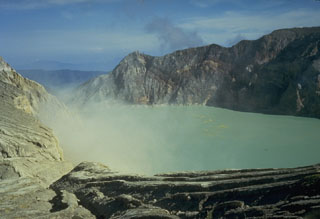Report on Ijen (Indonesia) — November 1998
Bulletin of the Global Volcanism Network, vol. 23, no. 11 (November 1998)
Managing Editor: Richard Wunderman.
Ijen (Indonesia) Recent measurements of acid crater lake
Please cite this report as:
Global Volcanism Program, 1998. Report on Ijen (Indonesia) (Wunderman, R., ed.). Bulletin of the Global Volcanism Network, 23:11. Smithsonian Institution. https://doi.org/10.5479/si.GVP.BGVN199811-263350
Ijen
Indonesia
8.058°S, 114.242°E; summit elev. 2769 m
All times are local (unless otherwise noted)
Measurements and sampling were made in the acid lake of Kawah-Ijen during two transits with a rubber rowboat on 7 and 10 December 1998. The 7 December measurements occurred just after heavy rain and the lake's color was pale and nearly white. In the middle of the lake, the surface temperature was 23.5°C with a pH of 0.48 as a result of dilution by the rain. The temperature near the solfatara at the S side of the lake ranged between 24.6 and 24.9°C with a pH of 0.45. Near the hot sublacustrine spring the temperature was as high as 61.7°C and the pH was 0.60. In the Banyupahit River, 3 km from the dam that closes the lake, the water had a temperature of 21.1°C and a pH of 0.47.
Three days later, 10 December, the lake was pale green with localized brown coloration; the temperature of the surface was 24.8-25.2°C and the pH 0.36-0.38. The highest measured temperature of the solfatara was 224°C, while the CO2 content of the atmosphere near the lake surface was normal, ~300 ppm.
Geological Summary. The Ijen volcano complex at the eastern end of Java consists of a group of small stratovolcanoes constructed within the 20-km-wide Ijen (Kendeng) caldera. The north caldera wall forms a prominent arcuate ridge, but elsewhere the rim was buried by post-caldera volcanoes, including Gunung Merapi, which forms the high point of the complex. Immediately west of the Gunung Merapi stratovolcano is the historically active Kawah Ijen crater, which contains a nearly 1-km-wide, turquoise-colored, acid lake. Kawah Ijen is the site of a labor-intensive mining operation in which baskets of sulfur are hand-carried from the crater floor. Many other post-caldera cones and craters are located within the caldera or along its rim. The largest concentration of cones forms an E-W zone across the southern side of the caldera. Coffee plantations cover much of the caldera floor; nearby waterfalls and hot springs are tourist destinations.
Information Contacts: Jacques-Marie Bardintzeff, Laboratoire de Petrographie-Volcanologie, bat 504 Universite Paris-Sud, 91405 Orsay, France.

